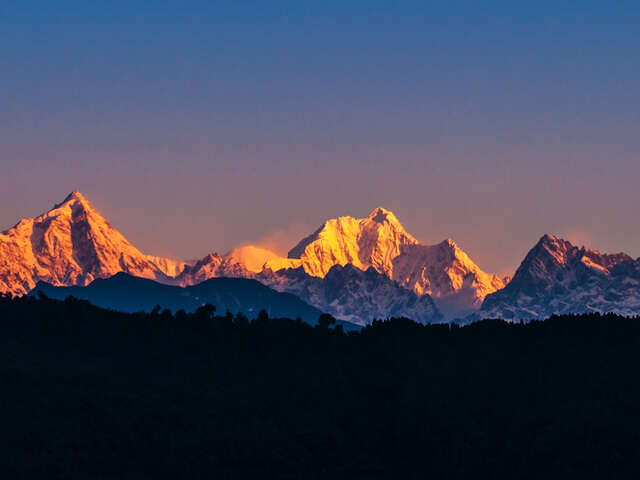Kanchenjunga National Park is a pristine expanse of natural beauty and biodiversity. Spanning over 850 square kilometers, this UNESCO World Heritage Site is named after the world’s third-highest peak, Kanchenjunga, which towers at 8,586 meters. The park, established in 1977, is not only a sanctuary for diverse flora and fauna but also a hub for trekking and adventure tourism. This article delves into the park’s unique features, ecological significance, and the myriad opportunities it offers to adventurers and nature lovers alike.
Ecological Significance
Kanchenjunga National Park is famous for its rich biodiversity, hosting a variety of ecosystems ranging from temperate forests to alpine meadows. The park is home to over 150 species of mammals, 600 species of birds and countless species of plants and insects. Among its most notable residents are the elusive snow leopard, red panda, and Himalayan black bear, which thrive in this rugged terrain.
The park’s diverse habitats are crucial for maintaining ecological balance. The forests, primarily composed of oak, rhododendron and pine, play a vital role in carbon sequestration and provide essential resources for local communities. Additionally, the park is part of the Kanchenjunga Biosphere Reserve, which enhances its ecological significance and promotes conservation efforts.
Flora and Fauna
The varied altitudes and climates within Kanchenjunga National Park give rise to an astonishing range of biodiversity. In the lower elevations, lush temperate forests abound, teeming with species like the blue pine, fir, and birch. As the altitude increases, the vegetation shifts to alpine meadows adorned with vibrant rhododendrons and various wildflowers, creating a breathtaking tapestry of colors during spring.
The park is also a haven for wildlife enthusiasts. The elusive snow leopard, a flagship species of the region, roams the higher altitudes, while the red panda, often seen climbing trees, captivates visitors with its playful demeanor. Other noteworthy mammals include the Himalayan tahr, serow, and a variety of deer species. Birdwatchers will be thrilled to spot species like the Himalayan monal, blood pheasant, and various vultures soaring above the stunning landscapes.
Cultural Heritage
Kanchenjunga National Park is not just a natural wonder; it is also steeped in rich cultural heritage. The region is home to several indigenous communities, including the Lepchas and Bhutias, who have coexisted with the natural environment for centuries. Their traditional knowledge and practices contribute significantly to the conservation of the park’s biodiversity.
Local customs, folklore, and religious beliefs are intricately linked to the mountains, particularly Kanchenjunga, which is revered as a sacred peak. The Kanchenjunga mountain range is a focal point of many local myths, and its protection is woven into the cultural fabric of the surrounding communities.
Trekking and Adventure Tourism
For adventure enthusiasts, Kanchenjunga National Park offers some of the most breathtaking trekking routes in the world. The Kanchenjunga Base Camp trek is particularly popular, attracting trekkers from around the globe. This challenging trek provides unparalleled views of the majestic peaks and offers a unique opportunity to experience the park’s rich biodiversity firsthand.
The trek usually starts from the town of Pelling or the village of Yuksom, winding through lush forests, picturesque villages, and alpine meadows. Trekkers are rewarded with stunning views of Kanchenjunga and other nearby peaks, creating unforgettable memories. The best time for trekking is during the spring (March to May) and autumn (September to November) seasons when the weather is most favorable.
Conservation Efforts
As a UNESCO World Heritage Site, Kanchenjunga National Park is the focus of various conservation initiatives aimed at preserving its unique biodiversity. The Indian government, along with numerous NGOs and local communities, is actively involved in protecting the park’s ecosystems.
Efforts include anti-poaching measures, habitat restoration, and community awareness programs. The participation of local communities is crucial, as their traditional practices often align with conservation goals. By involving these communities in conservation efforts, the park not only benefits from their knowledge but also ensures that they receive the socio-economic benefits of sustainable tourism.
Challenges and Future Prospects
Despite its ecological importance, Kanchenjunga National Park faces several challenges. Climate change poses a significant threat to its delicate ecosystems, affecting species distribution and the health of flora and fauna. Additionally, increasing tourism can lead to environmental degradation if not managed sustainably.
To address these challenges, it is essential to implement responsible tourism practices and enhance community involvement in conservation. This can include promoting eco-tourism, regulating visitor numbers, and ensuring that tourism revenues contribute to local development.
Conclusion
Kanchenjunga National Park stands as a testament to the breathtaking beauty of nature and the richness of biodiversity. It is a sanctuary for countless species, a treasure trove of cultural heritage, and a paradise for adventure seekers. As we look to the future, it is imperative to balance the needs of conservation with the aspirations of local communities and the growing demand for eco-tourism. By doing so, we can ensure that this magnificent park continues to thrive for generations to come, preserving its natural wonders and cultural significance in the heart of the Himalayas.





Comments